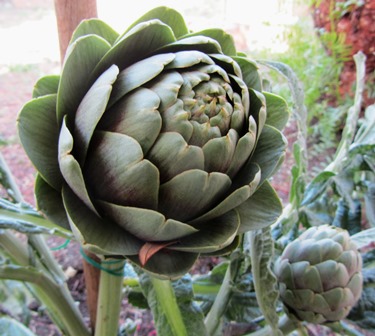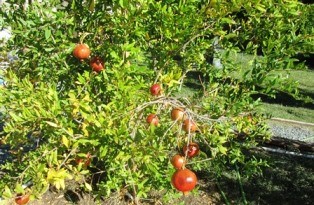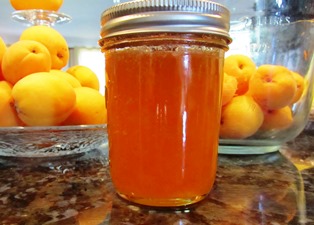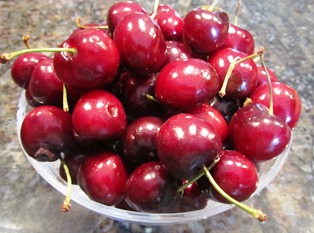Growing Your Own Superfoods
Nutrient-rich fruits, vegetables, and berries are not difficult to grow. Some can even be grown in containers on a sunny patio. My favorite superfoods include blueberries, strawberries, raspberries, and blackberries as well as artichokes, assorted leafy greens, and figs. But in general, superfoods are those foods rich in nutrients, vitamins, fiber, antioxidants, and/or omega-3 and omega-6 fatty acids.
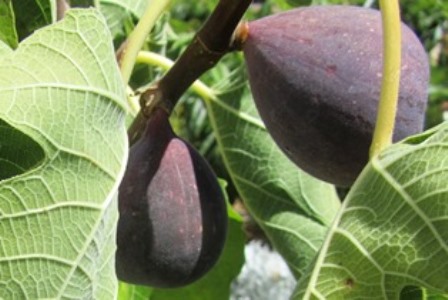
The dark purplish color is characteristic of the brown turkey fig, and this tree needs a lot of space in the garden
On the farmette, I’ve planted several fig trees that are semi-dwarf and include White Genoa, Brown Turkey, and Mission varieties. These trees produce two crops each year–one in spring and the other in the fall. The fruits can be dried or eaten fresh and contain omega-3 and omega-6 fatty acids and phenol for the prevention and treatment of coronary heart disease.
I’ve planted raised beds of strawberries, including Albion, a variety that produces berries from June to October, and Sequoia, a dependable berry that produces fruit from June to early frost.
In half barrels, I’ve amended soil and planted thornless raspberries and blackberries. I like growing them in containers with trellis support because otherwise they spread all over any area of the garden where they’re planted.
We planted one artichoke a couple of years ago. It dies back in late fall only to return in the spring as a new plant with shoots containing the small chokes. Artichokes are low in calories and aid in the lowering of cholesterol because of specific compounds found in the edible parts of the plant.
Early in the spring when I put in my sweet garden peas, I also plant leafy greens such as kale, collards, lettuces, and spinach. Some of these come back the next year after their growing season is over.
Blueberries are easy to grow when you remember to plant them in acid soil. These berries are considered a superior brain food. They are low in calories (84 calories per cup) and provide about 24 percent of the suggested daily amount of Vitamin C that the body needs.
Except for the fig trees and the artichokes that do better in areas of the garden where they have plenty of space to spread, the other nutrient-rich foods mentioned can all be planted and raised in containers. It’s so easy to grow most of these plants, why not give it a try.
To-Do List of Chores for the Fall Garden
From my office widow, I look out over what once was a lush and thriving garden. Not so today.
I can hardly bear to gaze upon the sorrowful, dried tomato vines that for me have come to symbolize the severity of the extreme drought on California gardens.
Now that fall will soon arrive, I’ll toss onto the compost pile those vines along with others from pumpkins and hard-shelled squash.
So with the garden cleared, I’m thinking ahead to next year, ever hopeful we’ll get rain rather than a repeat of dry conditions like this past year.
To ensure the viability of our fruit trees, citrus trees, and various berries through the fall and winter, there is a spray regimen to be initiated. I’ll add it to my long list of chores that will need to be done.
MY FALL CHECKLIST FOR THE GARDEN
Turn the soil, add amendments like compost to hold in the water.
Prepare new beds.
Build cold frames and 4- x 6- foot boxes for new raised beds.
Cut the canes of blackberries (berries only set up on two-year-old canes that won’t again produce; cut to ensure new fruiting canes will take their place).
Prune away the spent floricanes of red raspberries, once they’ve produced fruit.
Clean up around the bases of all trees and evergreen plants; add mulch.
Also remove all leaves at the base of all fruit trees and dispose.
Remove rose leaves after blooming season, cut canes to 18 inches, and spray for diseases and pests.
Stake young trees so they’ll survive windy winters, growing straight and tall.
Treat the trees with an organic spray (one containing copper and protector oil) to prevent fungal disease and pests.
Get out the frost cloth in readiness to cover tender citrus trees.
Prune back the hydrangeas.
Plant fall bulbs for spring flowering.
Jam, Jelly, Conserve, & Fruit Butter
I admit to having a weakness for palate-pleasing soft spreads made from fresh fruit. My taste for fruit spreads started in my childhood with my grandmother, who introduced me to the process of picking and preserving the fresh seasonal fruits we found on the farm–mulberries, damson plum, blackberries, gooseberries, and peaches.
My grandmother would load the breakfast table with hearty farm-to-table foods and hot, freshly made biscuits that we slathered with butter. I could always count on at least a couple of bowls of jams or jellies. For us farmers, breakfast and lunch were the most important meals of the day, providing us with energy for the hours of toil that followed those meals.
Later, as an avid traveler, I fondly remember breakfasts in the United Kingdom and throughout Europe, especially France, where my petit déjeuner included strong coffee, juice, and bread (usually some type of roll such as brioche or croissant), butter, and an exquisite soft spread of jam, jelly, fruit butter, or conserve. You might wonder, what’s the difference?
Jam: made from fruit, sugar, and pectin (to thicken) that are boiled to achieve a spreadable consistency
Jelly: made from juice (from various ingredients or fruit that has been crushed and strained), sugar, pectin, and acid, gently boiled to render clear color and firm shape
Conserve: fruit and nut spreads that are chunky; they make a nice condiment for certain meat dishes and cheeses, like a goat cheese with fig-walnut conserve
Preserves: fruit in jelly
Fruit Butter: made from fruit that has been slow cooked until creamy and color is opaque or translucent
As I write this, I have four cases of organic ripe apricots and cherries on my kitchen counter from the farmer’s market. So, like my grandmother, I’m going to eat my breakfast and then work for the next several hours preserving these delicious seasonal fruits into spreads for future breakfasts.
Blackberries and Dumplings
I dug up ensnarled blackberry vines yesterday and threw the lot into a bucket for replanting elsewhere on the farmette. Originally planted next to a fence, the vines had, over the last year, tangled into the roses and lavender that I had planted too near to them. Blackberry vines have a habit of spreading.
While cutting the vines, I recalled the blackberries and dumplings that my grandmother used to make in her small, but utilitarian farm kitchen near Booneville, Missouri.
We would set off in the early morning to gather the blackberries that grew in thickets around the farm. When our galvanized pails of berries grew heavy, we’d trudge back to the farmhouse.
My job was to wash the berries while my grandmother took a blue-striped yellow ware mixing bowl from the old Hoosier cabinet and began assembling the dry ingredients to make dumplings.
Dumpling ingredients:
1 cup all-purpose white flour
1 1/2 teaspoons baking powder
1/2 teaspoon salt
1/2 teaspoon baking soda
1 cup, plus 1 Tablespoon sugar
1 large egg (with yolk separated from egg white)
2/3 cup buttermilk
3 Tablespoons of butter (2T for dumpling batter, 1T for skillet)
Two pints of freshly washed blackberries
Directions for making the dumplings:
Combine flour, baking powder, salt, baking soda, and a Tablespoon of the sugar.
Mix together in another bowl the egg yolk, buttermilk, and 2 Tablespoons of butter.
Slowly combine the wet ingredients into the dry.
Beat the egg white until peaks rise and then fold it into the dumpling batter.
Directions for cooking:
In a 10-inch cast-iron skillet over medium high heat, melt 1 Tablespoon of butter. Using a large spoon, drop half dozen or so of the dumpling batter into the butter and cook about five minutes until both sides are brown. Remove this batch and repeat until all batter is cooked. Then set the dumplings aside.
Pour the blackberries into the skillet with 1 cup sugar. Mix together until the berries and sugar simmer and then reduce the heat. Position the dumplings on top of the blackberries and cook for ten minutes. The dessert is best served warm. Serves 4 to 6.
 Facebook
Facebook Goodreads
Goodreads LinkedIn
LinkedIn Meera Lester
Meera Lester Twitter
Twitter






